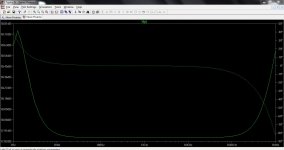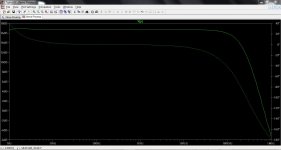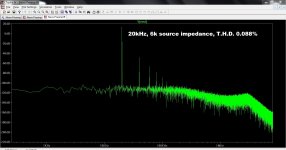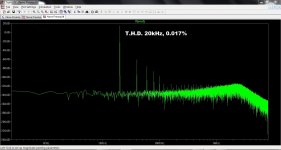Thanks. But I now have a better question!
I want to use a ground+power plane in addition of course to good grounding techniques, for the RF benefits. Obviously you don't want signal going through the ground plane, so except for decoupling where problems would be worse if they did not. How does use of a ground plane affect good grounding practice?
Having a separate signal ground going across the ground plane would cause errors in the signal ground according to the currents flowing in the ground plane, but if you had a power plane on the other side of the ground plane, the power return currents would magnetically cancel. My question is, would the errors in induced in the signal ground actually be worse this way than they would be without a ground plane, where the power loop currents are free to radiate?
!personally I would buy Henry Otts books as well as others and look around the internet for information on analogue design and ground planes...Its only high powers stuff such as power amp outputs, for low level analogue you can use 1 ground plane. And most would get better results using a single contiguous ground than they would trying to work out where the currents are going as most don't really understand return currents so tend to over complicate the ground layout on PCBs.
Last edited:
Some will say that it is a problem with perception, but I trust my ears, they have rarely failed me, EXCEPT in ABX double blind tests set up by engineers and professors.
Where you cant see?
After listening to a Rupert Neve lecture from early 2000, I was inspired as to WHY the OLD circuits often sound better than the NEW circuits? They certainly don't measure 'better' but they can make memorable recordings, and can keep the essence of the musical performance better than digital or IC based designs do.
I am putting up one of Rupert Neve's early designs from the '60's. You will find that the Ampex tape recorder circuits at the time we about the same, and I made a number of successful recordings with them. Perhaps not as good as the vacuum tube electronics that preceded them, but better than the NEXT generation of electronics in the 70's that was IC based. Rupert Neve was very specific about what he found and why. I found the same thing independently at the time and still use the same design principles, today. Perhaps we can discuss this 'simple' circuit in more detail.
http://www.diyaudio.com/forums/loun...ch-preamplifier-part-ii-5196.html#post3920876
The simple tool for assessing is to pass the signal through the stage multiple times - what do you end up with, compared to the original? The ideal is obvious, but in the real world there are inevitable losses: if the "laboratory" version is technically more aligned to the start, but an artifact of unpleasantness has been gradually mixed in, vs. another circuit which is quite coloured by the end, but still possesses a high level of listenability, it doesn't offend the ears - then, which is 'superior'?
Care to explain in simpler terms please, I don't quite get what you are saying!
Last edited:
The "laboratory" stage creates a version which nominally is relatively undistorted, by conventional measuring, but some quite irritating low level "incorrectness" is introduced via the multiple passes; the other unit doesn't pass normal testing with flying colours, there is obvious colouration, which can be measured - but there is no irksome quality as part of that.Care to explain in simpler terms please, I don't quite get what you are saying!
This is priceless! Your ears always work, except when you have to rely on them alone?john curl said:Some will say that it is a problem with perception, but I trust my ears, they have rarely failed me, EXCEPT in ABX double blind tests set up by engineers and professors.
And how is an ABX test different than what you are describing unless the setup is faulty to begin with? As long as your requirements are met you should have the same results in a blind test as a sighted tests disregarding any psychological cues given by a sighted test.
Keantoken, I'm glad that you simulated the Neve preamp. I was tempted to build one up and test it myself, but I am not surprised that it measures fairly well. However, there is more to it than that: After all most IC's today can measure even better, but they will not sound as good, usually. Do you think that Rupert Neve and I did NOT test, by both measurement and LISTENING, virtually every IC op amp that came on line over the years?
But there are other factors, intrinsic to the design that apparently makes the difference between preamps.
For example, THD is USELESS. But looking at the harmonic spectrum derived from THD is useful! Then you have to WEIGHT the odd harmonics significantly, so that 7th and 9th harmonic, if there, stick out like a sore thumb, and give you fair warning. That is just ONE of the qualities that the Neve excels in compared to many IC's. IF you would just listen to Rupert Neve on U-tube (can it be so difficult?) you would hear my explanations from his lips, yet I have never met or corresponded with the man. It is called 'experience' everybody, by someone who makes his way by making successful audio designs. Trust me, IC's would be cheaper and easier to implement, and we would use them, if we could.
But there are other factors, intrinsic to the design that apparently makes the difference between preamps.
For example, THD is USELESS. But looking at the harmonic spectrum derived from THD is useful! Then you have to WEIGHT the odd harmonics significantly, so that 7th and 9th harmonic, if there, stick out like a sore thumb, and give you fair warning. That is just ONE of the qualities that the Neve excels in compared to many IC's. IF you would just listen to Rupert Neve on U-tube (can it be so difficult?) you would hear my explanations from his lips, yet I have never met or corresponded with the man. It is called 'experience' everybody, by someone who makes his way by making successful audio designs. Trust me, IC's would be cheaper and easier to implement, and we would use them, if we could.
Last edited:
If I have done this correctly then this is the F.F.T. for the Neve at 20kHz with 1 volt input. As I mentioned earlier, the design is critically dependent upon the source impedance feeding it to get a flat response both at lf and hf.
Edit... second image is from a low (1ohm) source.
Edit... second image is from a low (1ohm) source.
Attachments
- Status
- Not open for further replies.
- Home
- Member Areas
- The Lounge
- John Curl's Blowtorch preamplifier part II



